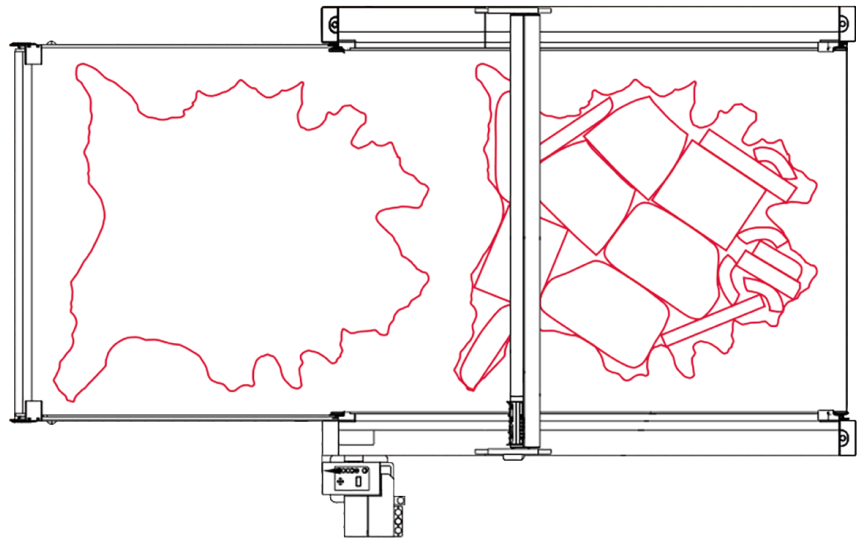
The leather applications
Patterned or motive printed textiles are by far not regular in the cause of a fabric roll. Distortions can run straight line to a curve, the repeat size of pattern varies within the roll.
The cut-order (marker) needs imput of the actual course of the pattern with its distortions and irregularities (skew & bow). This happened in the past not automaticly. Not only the visual power of humans judgment was needed by interaction, but also a great expense of technology (hardware/software), often combined with a limitation of matching methods.
One programme - a huge range of applications
The RHINO leather cutting system can be applied and configured for prototype-building, for small series and for mass production in the automotive-, aircraft-, upholstery- and related industries. In addition to full automation, the user can if necessary determine freely and at any time the level of interactive influence over the nesting/cutting results. RHINO is also offered in software modules, e. g. for warehouse entry and hide-inspection and for optimising roller die cutters.

Configurations
The system can be configured according to the following process steps: Job management, capture hide contour and quality areas (1), nesting the templates (2), automatic cutting (3) and sorting (4).

Configurations 1
The smallest configuration (prototyping) consists of a cutting table sized to take up one or more hides (depending on area). All the process steps mentioned above are carried out in sequence. The individual process times accumulate per cut/order.

Configurations 2
The increase in capacity is done by a conveyorised table extension in order to enlarge the work surface at the infeed of the cutters by one segment. This allows the processes of hide capture, nesting and cutting to be run in parallel. Capacity thus increases by approx. 180 percent.

Configurations 3
Configuration 2 is extended by another conveyorised table segment in the area of discharge (sorting). Processes 1- 4 can thus run in parallel and simultaneously. This helps you achieve a nearly 300% performance boost over the single-table solution.
The processes
Hide capture
The hide laid out on the table is scanned with a high resolution camera. This captures the hide contours, the hide structure (natural characteristics, holes, grain) and all indicated quality symbols for the definition of usable areas (4 Q-zones). Along with the evaluation of the hide illustration, the system stores all the relevant hide parameters in the integrated data base.


Nesting process
The database-supported job management delivers the amount of templates for automatic nesting onto the current hide. The process time of the automatic nesting can be controlled automatically, depending on the cutting time. With particularly sensitive products, the user can either nest via option „beamer nesting“ (with multi-function mouse) or place selected cut parts on the screen and then leave optimisation of the remaining usable area to the automatic function.
Cutting
In the three-table segment configured for high capacities, there are constantly three hides in the overall process (capture, cut, sort), of which one is always cut. Minus the short conveying times, the cutter, as the pacesetter of the system, with a capacity utilisation of over 90 percent, ensures virtually non-stop production.
Sorting of the finished cuts
As soon as the cutter has conveyed the contents of its cutting window to the third table segment, the sorting process can begin. The RHINO system offers a beamer-supported sorting aid as an option.
Option for roller die cutters
The system combines the processes of hide detection and automatic nesting with the punching process. Through it, the final, optimised cutting image (marker) is projected by a highintensity beamer onto the hide and the punch dies are accordingly placed.
